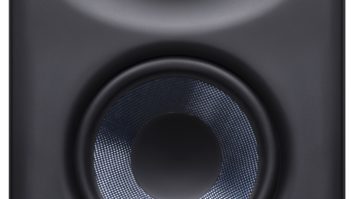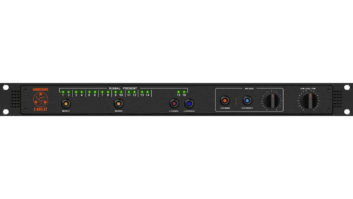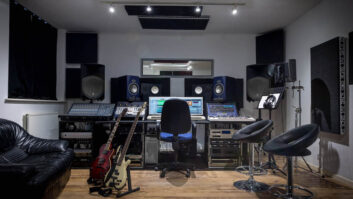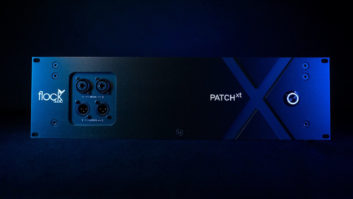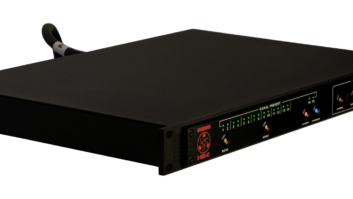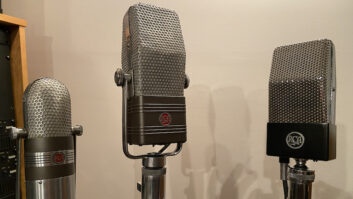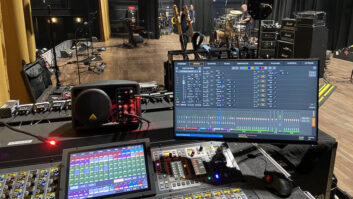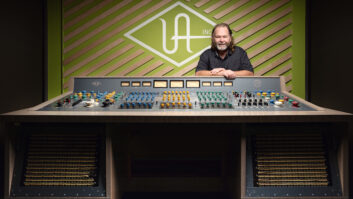The new CMC 6 xt mic body from Schoeps is the latest update to the
Colette modular mic system. The body, which can be powered by either
48-volt or 12V power supplies, can be joined to any of the axially
addressed Colette capsules (nine in all) to achieve a frequency
response beyond 40 kHz. The matte-gray unit used for the test looked
like the standard CMC 6 except for the “xt” (extended)
printed at the base near the connector. I paired the xt with the MK 41
universal supercardioid capsule.
THE TEST
In the past, I’ve used other extended-range mics such as the Sennheiser
MKH-800 and several from Earthworks with good results, so I was
interested to try the xt. I had the perfect opportunity to test the mic
on a CD project that would involve recording a variety of acoustic
instruments at varying sampling rates.
I first used the xt on an acoustic guitar. After having great
results in the past with the standard CMC 6, I expected at least the
same from the xt and got it. What’s easy to like about the xt is the
smooth, silky top end and its size; because it’s so light and tiny,
it’s very easy to maneuver into tight spots. It was a winner in this
application and became the first-call guitar mic for the rest of the
session. I found myself wishing for a pair to try in stereo.
Next, I had various bluegrass players come in for overdubs and used
the mic on upright bass, fiddle, mandolin and banjo. For the upright, I
used two mics: one cardioid large-diaphragm near the floor, pointing
up at the bridge, and the xt up closer to the players’ right hand to
capture more of the string noise and attack. The combination sounded
fantastic and allowed me to mix the lower and upper mics to taste. The
detail that the xt afforded at the top was perfect and gave just the
right balance that I was looking for. The xt is no wimp on the low end,
either. When I isolated the xt, I had a very usable upright track,
although I had to add some EQ at 100 Hz or so because of the mic’s
placement.
The mandolin sounded great, as well, and when mixed, it cut through
the rest of the instruments without sounding harsh; ditto for banjo.
Transient response was very good on an instrument that is loud and can
tend to be annoyingly harsh. The fiddle was interesting in that I had
to mike it closer than I would have liked to because the player was
inexperienced and played quietly. The room had some ambient noise that
I didn’t want to be a factor, so I close-miked this usually
scratchy-sounding instrument. The xt did a standup job, giving me
plenty to work with later on when I had to add some EQ to warm it
up.
An unexpected but revealing use of the mic came when I had to record
a small children’s choir. I first put up an expensive, self-powered,
large-diaphragm vocal mic to do the job and quickly discovered that the
kids were overloading the mic (the power of youth!). Unfortunately, the
mic had no pad, so I had to make a quick decision, not wanting to lose
my short-attention-spanned artists. The xt happened to be up on a stand
so I quickly plugged it in and sent it through a Millennia STT-1 mic
preamp. The results were very good and much better than I had expected.
It took plenty of level and gave me a track that did not need EQ’ing
during the mix.
CONCLUSION
Frankly, without close A/B’ing with the standard CMC 6, I’d find it
hard to discern if I was getting the extended response promised by
Schoeps. But I did have one interesting thing happen that made me an xt
believer: On a solo guitar piece, I was working with an acoustic guitar
that I had recorded previously on a number of occasions so I was
familiar with the instrument. During the session, I put up the xt, got
the sound and started recording the track. During playback, I noticed
that the harmonics were especially clear, present and bright. I asked
the artist if she had changed her strings and she said no, these were
old. Bing! I found that very interesting and telling, especially
because that track was recorded at 48k. In addition, aside from the
sonic beauty that the xt captures, it’s especially nice to be able to
choose exactly the capsule that you want. At $610 (body only), it’s a
good deal. I’m sold.
Schoeps, www.schoeps.de
TEST SIGNAL CHAIN
Interconnect: Hosa Pro mic cable
Mic Preamp(s): Millennia STT-1, Daking 52270B, Focusrite ISA
428
Multitrack: Pro Tools|HD
Power Amp: Crown Com-Tech 400
Speaker Cables: DiMarzio M-Path
Speakers: Westlake Lc 5.75
The room is approximately 13×25 feet with a peaked wooden ceiling,
carpeted floor and textured stucco walls with plenty of natural
diffusion.
